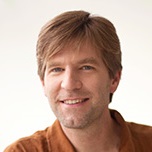John T. Groves
Chemist Faculty Scientist
Biography
Jay T. Groves received his B.S. degree in Physics and Chemistry from Tufts University, and then went on to complete his Ph.D. in Biophysics with Professors Steven Boxer and Harden McConnell at Stanford University. He then spent a year as a visiting scholar at Academia Sinica in Taipei, Taiwan before becoming the Division Director’s Fellow in the Physical Biosciences Division at Lawrence Berkeley National Laboratory. In 2001 he joined the Chemistry Department at UC Berkeley as an Assistant Professor. He was promoted to Associate Professor in 2007 and Professor in 2010. In 2008 Professor Groves was appointed as a Howard Hughes Medical Institute Investigator. He has received the Burroughs Wellcome Career Award in the Biomedical Sciences (2000), the Searle Scholars Award (2002), the MIT TR100 (2003), the Beckman Young Investigator Award (2004), and the NSF CAREER Award (2005). He has served as an Associate Editor of the Annual Reviews of Physical Chemistry since 2006.
Research Interests
Professor Groves is primarily interested in role of spatial organization in biochemical reaction systems. Living cells are not at all well-mixed reaction chambers. Rather, the molecular processes of life occur in elaborate spatial patterns. This interplay between spatial organization and the chemical reactions themselves in living systems adds a fascinating new dimension to chemistry that is rarely encountered outside of biology. Specific research in Professor Groves’ laboratory focuses on how spatial organization influences signal transduction processes at the cell membrane. The research methods combine techniques in optical microscopy and spectroscopy with materials fabrication methods and cell biology. This integrated approach enables the direct observation and physical manipulation of living reaction systems, down to the single molecule level. The conceptual approach is rooted in physics and physical chemistry, with the overarching goal of developing a quantitative and mechanistic understanding biochemical processes in living systems.
Recent Publications
Related News
How T Cells Tune Out Fake Signals: Phase Transition Timing Is Everything
A group of Berkeley Lab and UC Berkeley physical chemists led by Jay Groves, faculty scientist in Molecular Biophysics and Integrated Bioimaging (MBIB), has—for the first time—imaged the process by which an individual immune system molecule is switched on in response to a signal from the environment. This breakthrough led to the discovery that the immune system activation process involves hundreds of proteins suddenly coming together to form a linked network through a process known as phase transition. Critically, the process has a built in time delay which allows the cell to distinguish a genuine receptor stimulation from background chemical noise. The work is described in a paper recently published in the journal Science.




